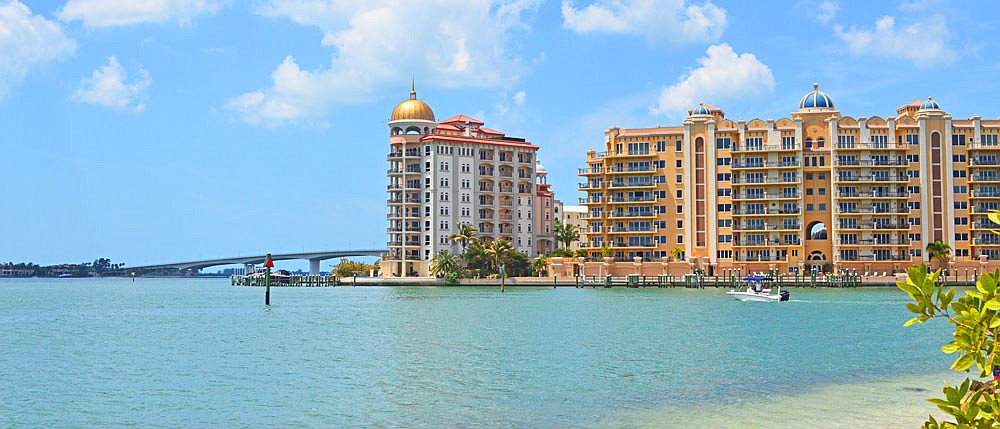- April 18, 2024
-
-
Loading

Loading

Golden Gate Point, a 22-acre peninsula adjacent to downtown Sarasota, was known as Cedar Point in the 1920s, when circus celebrity John Ringling owned the property. As recently as the mid ’90s, much of the land was still undeveloped. Now a premier location for a life of luxury, the community in 2005 voted for streetscape improvements that brought them brick streets, walkways and lavish foliage.
+ 100 Years Ago
In 1910, when Cedar Point consisted of a mangrove swamp filled with cabbage palms, Owen Burns purchased the property and became its first developer. Burns began dredging and filling and installing seawalls that expanded the strip of land substantially.
Burns and Ringling then collaborated on a plan for a bridge and causeway to connect the offshore islets of the Bird, St. Armands, and Lido keys to the mainland. They drove the first pilings for the bridge on New Years Eve 1925 and completed the Ringling Causeway at a cost of $425,000 in one year. The two-lane Ringling Causeway, formally opened in February 1926, remained the only land access from Sarasota to the three islets until 1959.
+ Cedar Point Becomes Golden Gate Point
The Sarasota City Council approved a new plat for Golden Gate Point in February 1925, but after paving its streets in 1926, many lots remained unsold, and no homes were built. The city expropriated some lots for unpaid taxes.
The collapse of the 1920s Florida land boom, the coming of the Great Depression, and the death of John Ringling in 1936 were severe setbacks to Golden Gate Point's development plans and efforts.
Newton Shockey, a manufacturer from Detroit, built the first house on Golden Gate Point in 1937 as a winter home. In June 1940, the Golden Gate Corporation formed and began construction of the four-unit Golden Gate Apartments in a Swiss chalet style, completing the structure the following December. The 12-unit Riviera Apartments on Golden Gate Point followed in 1941, and in 1945, a second single-family residence rose. A number of apartment buildings and motels, which later converted to apartments, as well as at least two single-family homes appeared in Golden Gate Point in the ’40s. By the early ’50s, many Golden Gate Point lots had been improved and developed, but just as many remained unimproved.
+ Development Accelerates
In 1957, all streets on Golden Gate Point became a single street with one name, Golden Gate Point Drive. In 1959, residents erected a sign for Golden Gate Point at the entrance from Gulfstream Avenue. In 1960, Golden Gate Point property owners and the city shared the cost of improved street lights.
In July 1973, when the tallest building stood 70 feet high, the City of Sarasota restricted building heights on Golden Gate Point to 75 feet. In 1978, a city survey showed 680 apartments and 1447 residents in Golden Gate Point.
In 1993, the city finally installed a traffic light at the entrance to the subdivision. Residents had requested a light for 25 years.
With construction of the large Renaissance Condominium in 1993, Golden Gate Point drew the attention of builders looking for waterfront sites for new, large-scale developments. Most single-family and multi-family buildings were outdated, some in deteriorating condition. The subdivision began a makeover that displaced many such structures over the next decade.
+ The Big Money Arrives
In July 2005, a developer offered a record $46 million to buy the 1950s Pier 550, a condominium converted from the former Seahorse Motel, planning to demolish the building and construct a new 62-unit, high-end condominium. Another developer offered even more, but ultimately neither offer went through, and Pier 550 remains today as one of the oldest buildings in Golden Gate Point.
Since 2000, Golden Gate Point has seen a tremendous transformation in light of new construction and landscaping. A few vacant parcels of land still await planned development. Most buildings are in fact new; however, more than a dozen dating back to the ’40s and into the ’70s have survived.
+ Marc Rasmussen is a broker and owner of DWELL Real Estate | 822-0708 | [email protected]